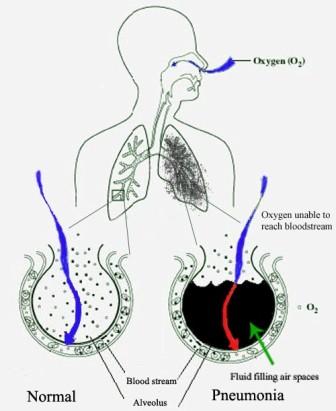Pneumonia history and symptoms: Difference between revisions
No edit summary |
|||
| Line 3: | Line 3: | ||
==Overview== | ==Overview== | ||
[[Image:New Pneumonia cartoon.jpg|thumb|250px|'''Pneumonia''' fills the lung's [[alveolus|alveoli]] with fluid, keeping oxygen from reaching the bloodstream. The alveolus on the left is normal, while the alveolus on the right is full of fluid from pneumonia.]] | [[Image:New Pneumonia cartoon.jpg|thumb|250px|'''Pneumonia''' fills the lung's [[alveolus|alveoli]] with fluid, keeping oxygen from reaching the bloodstream. The alveolus on the left is normal, while the alveolus on the right is full of fluid from pneumonia.]] | ||
People with infectious pneumonia often have a cough producing greenish or yellow [[sputum]] and a high [[fever]] that may be accompanied by [[rigors|shaking chills]]. | People with infectious pneumonia often have a cough producing greenish or yellow [[sputum]] and a high [[fever]] that may be accompanied by [[rigors|shaking chills]]. [[Shortness of breath]] is also common, as is pleuritic [[chest pain]], [[hemoptysis|cough up blood]], [[headache]]s, [[diaphoresis|sweaty]] and clammy skin. Other possible symptoms are [[anorexia (symptom)|loss of appetite]], fatigue, [[cyanosis|blueness of the skin]], [[nausea]], [[vomiting]], mood swings, and[[arthralgia|joint pains]] or [[myalgia|muscle aches]]. | ||
In elderly people manifestations of pneumonia may not be typical. They may develop a new or worsening confusion or may experience unsteadiness, leading to falls. Infants with pneumonia may have many of the symptoms above, but in many cases they are simply sleepy or have a decreased appetite. | |||
==History and Symptoms== | ==History and Symptoms== | ||
===Common symptoms=== | ===Common symptoms=== | ||
Revision as of 18:16, 5 September 2012
|
Pneumonia Microchapters |
|
Diagnosis |
|---|
|
Treatment |
|
Case Studies |
|
Pneumonia history and symptoms On the Web |
|
American Roentgen Ray Society Images of Pneumonia history and symptoms |
|
Risk calculators and risk factors for Pneumonia history and symptoms |
Editor(s)-in-Chief: C. Michael Gibson, M.S., M.D. [1] Phone:617-632-7753; Philip Marcus, M.D., M.P.H.[2]
Overview

People with infectious pneumonia often have a cough producing greenish or yellow sputum and a high fever that may be accompanied by shaking chills. Shortness of breath is also common, as is pleuritic chest pain, cough up blood, headaches, sweaty and clammy skin. Other possible symptoms are loss of appetite, fatigue, blueness of the skin, nausea, vomiting, mood swings, andjoint pains or muscle aches. In elderly people manifestations of pneumonia may not be typical. They may develop a new or worsening confusion or may experience unsteadiness, leading to falls. Infants with pneumonia may have many of the symptoms above, but in many cases they are simply sleepy or have a decreased appetite.
History and Symptoms
Common symptoms
- Dyspnea
- Productive cough (greenish or yellow sputum)
- Fever (high grade) with sweating, chills, and rigor
- Pleuritic chest pain
- Rapid, shallow breathing
Less common symptoms
Elderly
The manifestations of pneumonia, like those for many conditions, might not be typical in older people. They might instead experience:
- Delirium
- Hypothermia
- falls